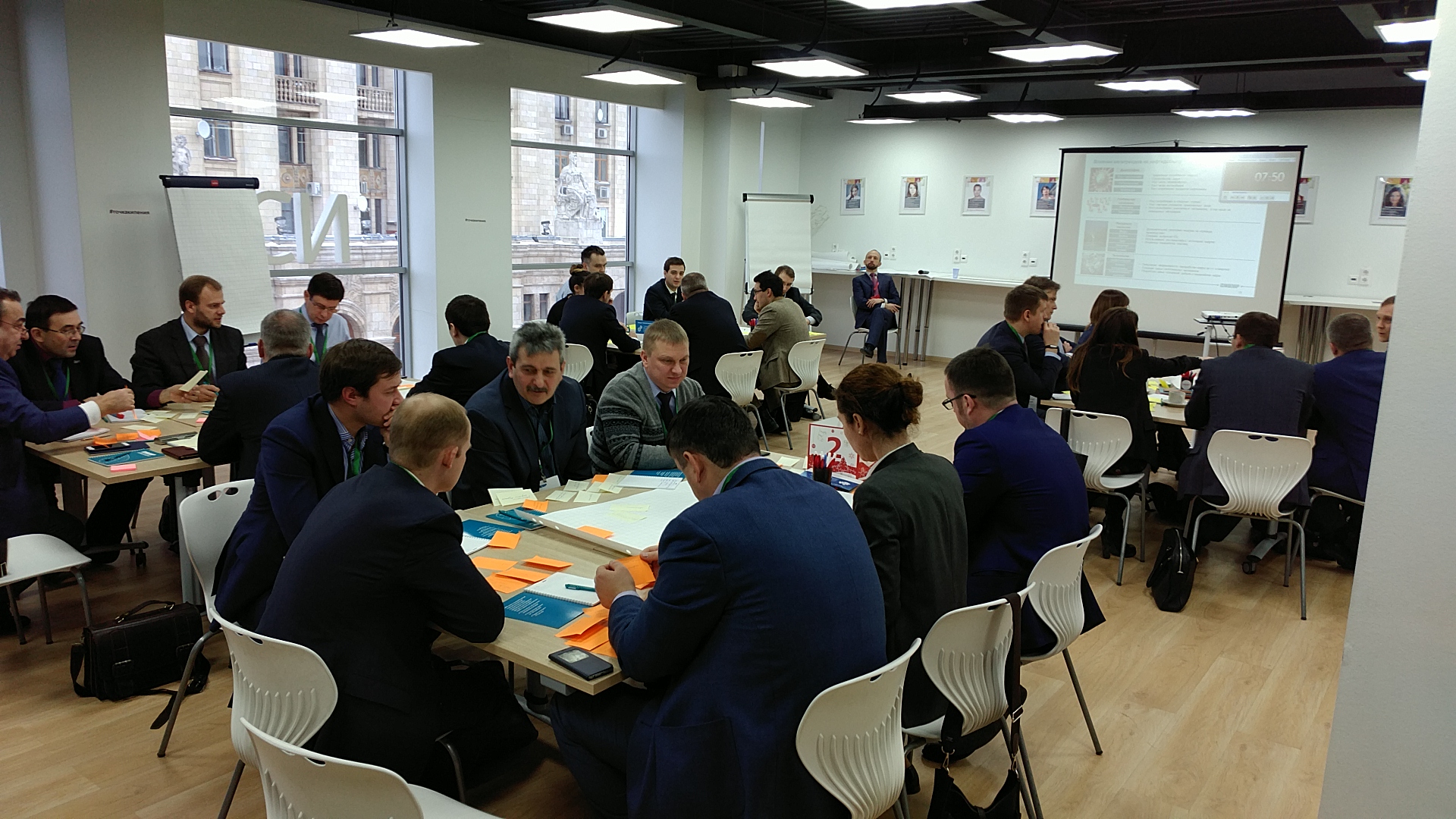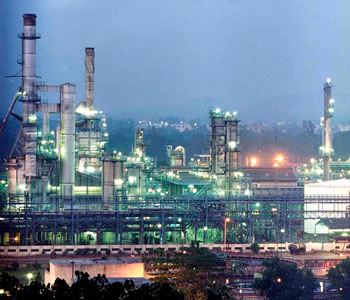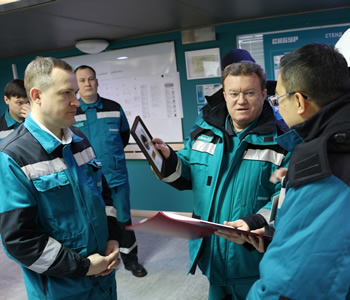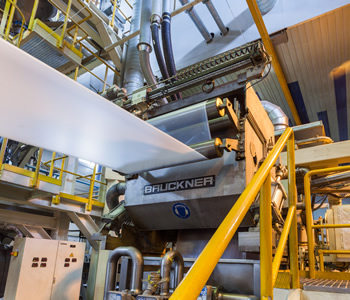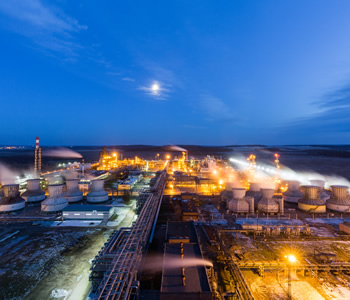
Session
participants
SIBUR
NIOST (R&D at SIBUR)
Gazprom Neft
Gazprom Neft R&D Centre
Skolkovo Institute of Science and Technology
Novatek R&D Centre
Lukoil
Halliburton
Tatneft R&D Centre
Novomet Perm
Strategy Partners Group
Gubkin Russian State University of Oil and Gas
Borets
Gazprom VNIIGAZ
How it worked
The session consisted of a series of thought showers, with SIBUR’s employees and third-party experts discussing the industry’s prospects with regard to its basic development scenarios.
“We sought to form a collaboration of people with most relevant industry expertise so that they would discuss the challenges and opportunities we face from a number of different perspectives. And we invited experts and heads of R&D from a number of oil and gas producers along with representatives of service companies, education professionals and researchers, equipment manufacturers and consultants,” said Dmitry Stepkin, Head of Corporate R&D at SIBUR.
Although the new collaboration format was not common for the participants, they found it highly efficient. “This effort brought together a unique group of best industry experts, generating valuable intra-industry insights. The SIBUR team did a really great job,” said Sergey Korotkov, Head of the Laboratory for Efficient Geological and Economic Use of Subsoil Resources at the Hydrocarbon Resources and Reserves Centre of Gazprom VNIIGAZ.
The top down approach was used for scenario modelling based on fundamental global trends already employed in the industry forecasting, with oil surplus and oil deficit as its extreme points.
Oil: what the future holds in store
The session participants named urbanisation, growing fresh water shortage and unforeseeable climate change among the key global drivers behind increasing hydrocarbons consumption. It was noted that mining companies would equally benefit from a decrease or an increase in global temperatures, as both would require more energy (for heating or air conditioning, respectively). More oil may be needed to fuel private commercial and passenger vehicles. Growing population mobility and a greater share of elderly people are two more, yet less significant, drivers for higher hydrocarbon consumption. Some boost to the demand may also come from the efforts to maximise agricultural yields and increasing popularity of customised products.
Hydrocarbon consumption could be reduced a lot through optimised transport costs, improved feedstock recycling, new types of materials and the development of green energy, including the use of renewable energy, stand-alone generators and energy storage.
![]()
The session participants’ consensus forecast
Potential reasons for oil deficit and a surge in oil prices
- Water scarcity and its growing importance
- Demand for customised/personalised products
- Greater focus on crop yields and lack of arable land
- Development of private passenger and commercial vehicles
- Growing urbanisation
Potential reasons for a drop of oil prices
- Renewable generation
- Optimised transportation and logistics costs (including internet technology-based optimisation)
- Stand-alone energy storage
- Feedstock recycling
- New nanoparticle and biomaterials
Lower consumption might also be supported by the growing virtualisation of our life and the expansion of the internet of things. An increased focus on carbon dioxide recycling and transition to Industry 4.0 technologies are other important trends potentially able to reduce consumption of hydrocarbons both in Russia and globally.
A number of other drivers discussed during the session were eventually considered irrelevant for the future of oil consumption, with tighter environmental regulations and technological requirements for businesses surprisingly among them, according to the experts’ voting results.
What it means for the petrochemical industry
After the trends discussion, the participants split into two teams to work our the industry development scenarios based on either deficit or surplus of hydrocarbons.
As it could be expected, the deficit-scenario team focused on technologies to boost hydrocarbons production and processing efficiency, including utilisation of smart materials (such as surfactants) for oil extraction and use of laser drilling. Together, these solutions would secure a higher hydrocarbon recovery rate. In case of oil deficit, the petrochemical industry would see further development of deep processing technologies coupled with the search for new sources of feedstock, such as value-added use of CO₂ in production.
Over the long-term horizon (until 2035), the deficit scenario would entail a broader use of biotechnology in the synthesis of polymers, such as the “production” of biomaterials by microbes. This does not exclude a reverse trend with natural materials substituting synthetic ones due to the feedstock deficit. Hydrocarbons extraction is expected to see a growing application of Industry 4.0 technologies, including use of drones, development of unmanned smart oil and gas fields, and automation powered by machine learning.
The surplus-scenario team focused on two key potential directions for the industry development in case of oil surplus. The first one involves greater volumes and quality of oil processing achieved by both conventional methods (plastics production) and highly exotic ones (such as oil-based food production). Oil extraction would be expected to stagnate or even decline, with excess oil potentially preserved for future generations.
![]()
Key technological developments involving petrochemicals and novel materials: the session participants’ view
- Roads made of polymers
- Plastics instead of metals
- Polymeric materials resistant to extreme temperature and pressure
- Viscoelastic surfactant solutions for advanced oil recovery
- Chemical recycling of waste and residue
- Biodegradable polymers
- Special medical polymers, including those used in implants
- Encapsulated sustained-action chemical products for targeted use
A continued hydrocarbons surplus would boost a spreading application of polymer materials (plastic roads, polymer paper, etc.) and development of technologies that would force other energy sources and conventional materials (end of coal power generation, replacement of metals with plastics, etc.) out of the market. Finally, over the long-term horizon (until 2035), oil may even be used for desalination as water would eventually become one of the scarcest resources, valued more than money. We can also expect cities to be built from plastics and sea islands made of bitumen and polymers. Finally, the surplus-scenario team came up with a full-blown concept of a future oil-centred city relying on hydrocarbons not only as feedstock, but also a popular social idea. The obvious, but still incredible scenarios also include an ubiquitous rise of 3D-printing, space tourism, and other developments.
What’s next?
"It takes 7–10 years or more to develop a new petrochemical product, so we need to look ahead to understand what are the right R&D projects for launch today, including those to be implemented in collaboration with our industry partners. This was the main purpose of our brainstorming session. We took note of a number of ideas that are now being further developed. We need to evaluate the key assumptions, competition and technological feasibility, find R&D partners and do a lot of other work. There is a long road ahead, but we are ready to go there with our partners and to create new competitive solutions,” said Dmitry Stepkin.
A glimpse into the future is a challenge, but also an inviting opportunity. The risk of error is high, but with no attempt to assess the future options our today’s work is pretty meaningless. Readers are welcome to respond to this publication and submit their views on the future of our industry. The most noteworthy of them will be published in the issues to follow.
Download PDF


